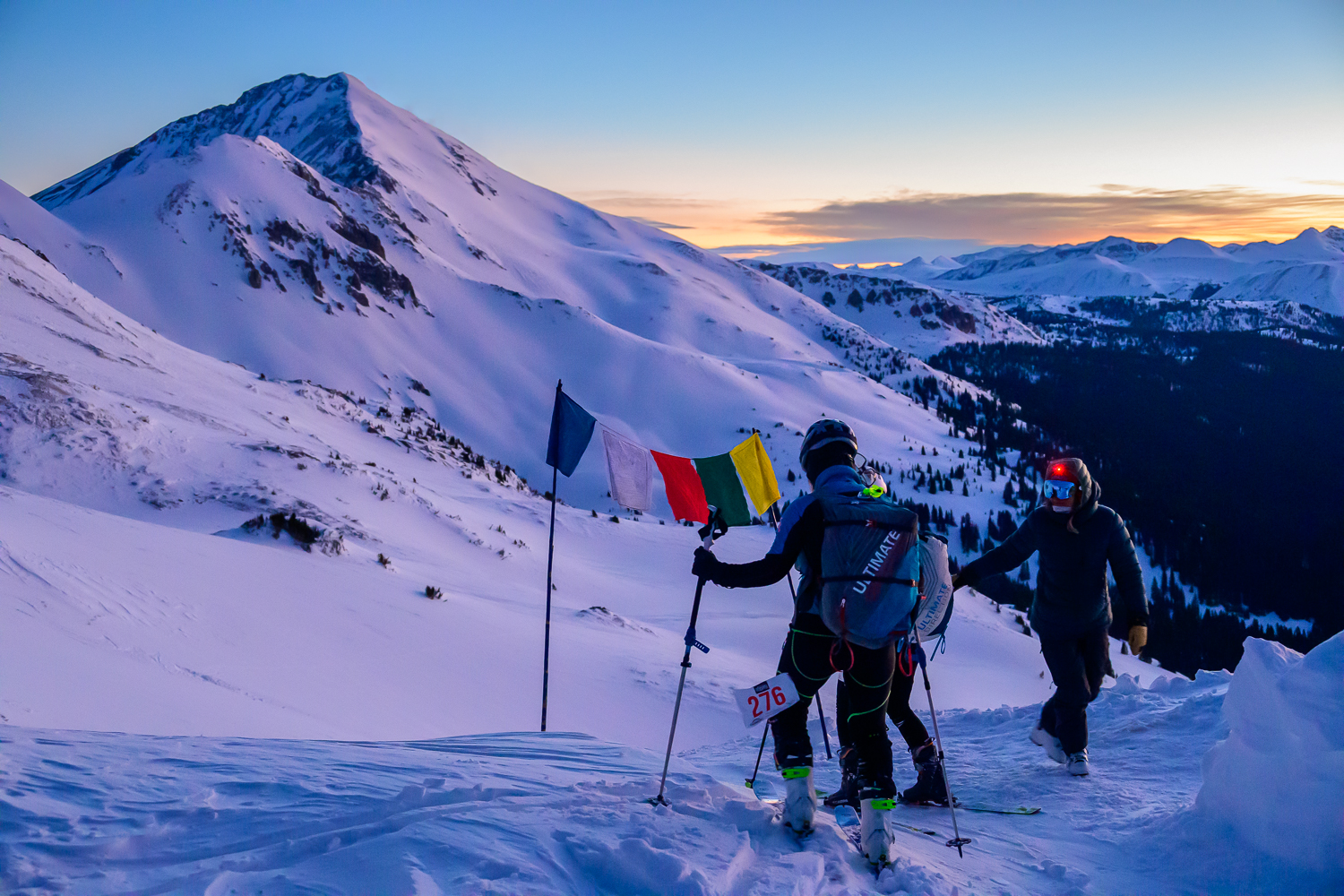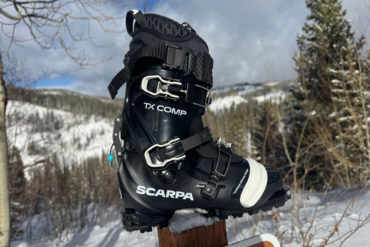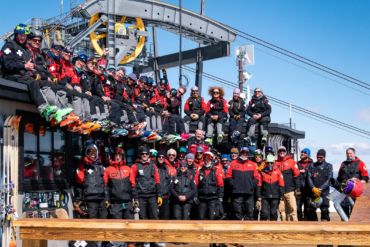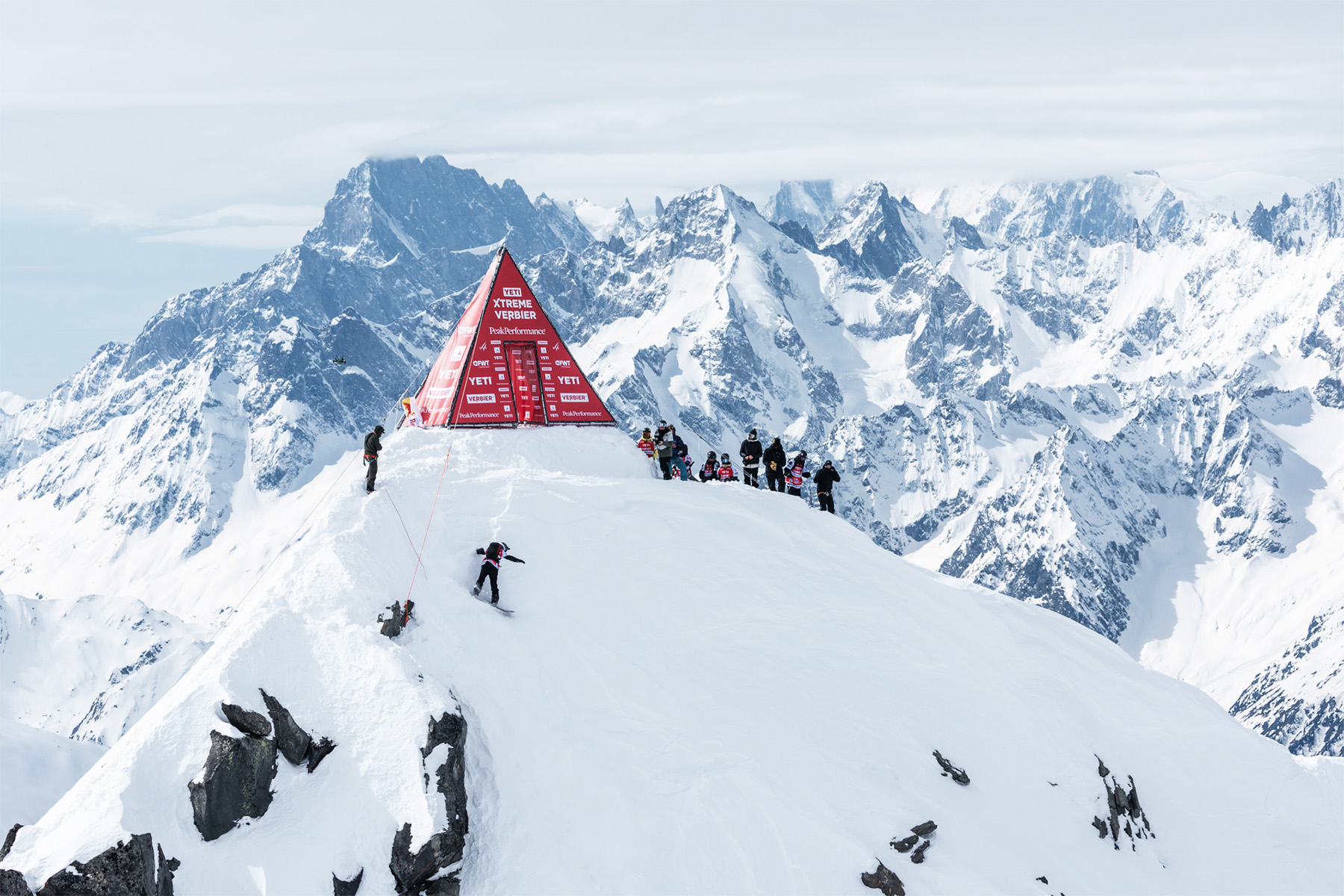You’re 17 miles in — nearly halfway. A warm glow is just barely creeping over the icy eastern horizon, and 1,200 vertical feet of skiing lie in front of you.
Enjoy it. Because it’s the best skiing you’ll get during the Elk Mountains Grand Traverse.
By this point, on top of Star Pass, you’ve been sweating in below-freezing temperatures since the race started at midnight. You and your teammate have been skinning in the dark. Blisters and fatigue are setting in. Your headlamp’s battery is starting to run low and your water may be frozen.
But for a few moments on top of Star Pass, there’s peace. You’ll make it to Aspen.
The Elk Mountains Grand Traverse has been pushing athletes’ feet and bodies to the absolute breaking point since 1998. It’s the toughest point-to-point ski race in North America. It’s a self-supported backcountry ski journey that starts at the base of Crested Butte, Colo., and finishes 40 miles away at the bottom of Aspen Mountain.
What lies between those two points is a blur to most racers. In reality, it’s a crossing of the Elk Mountains demanding nearly 8,000 feet of vertical gain up to a high point of over 12,400 feet.
Endless undulations and transitions, from the Brush Creek drainage to Taylor Flats to Richmond Ridge, push the limits of racers’ physical, psychological, and emotional capacity. Gear’s limitations are tested and often exceeded.
If the wintertime masochism wasn’t enough, Crested Butte Nordic, the event organizer and nonprofit beneficiary, expanded the traverse in 2014 to a summertime back-to-back run and bike of the same route. The three-race series, when completed in a single year, is known as the “Triple Crown,” the ultimate mountain athlete’s trifecta. Nikki LaRochelle holds the 2022 crown. And she’s out to defend it with a 2023 ski race win under her belt.
My ski partner, Clayton, and I took a stab at the 25th annual Grand Traverse this year; his first and my third. The first installment of a Triple Crown endeavor after completing the winter and summer legs in different years.
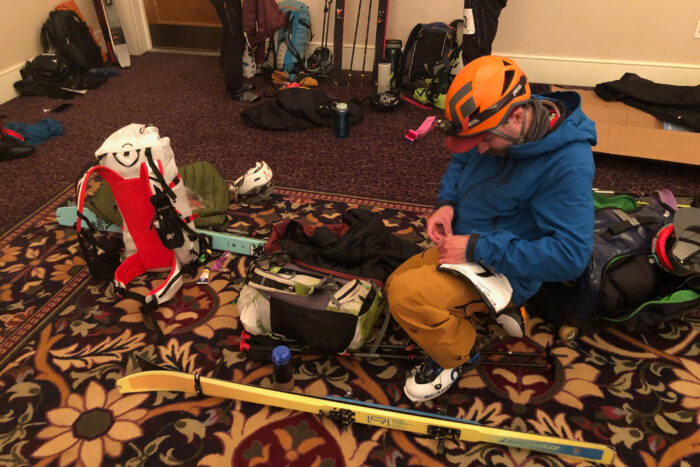
Preparing for the Traverse: Gear and Strategy
In some ways, the waiting and anticipation are the hardest parts about the ski. Five days out and the conditions were sketchy at best — considerable avalanche danger, with another 10-12 inches in the forecast. The safety teams winter camp along the course the preceding week — they’re the ones who have to make the call if the snowpack is stable enough to send all 400 racers through. If it’s not, that could mean a heartbreaking “reverse” or cancellation altogether.
That would mean that months of training and gear prep were for naught.
Standard Kit
I looked at our gear spread neatly across the floor. Immaculate organization and preparation are required to make it through to Aspen. Your water is going to freeze. The weather will probably be extreme. Your skins will likely stop sticking to your skis at some point. Something will break. You need to be prepared to get you and your partner to the finish line.
The top racers go ultralight. Not a gram of excess weight in their packs or on their feet. Each one counts when you’re pushing for the front of the pack and a sub-7-hour time. For most of the racers out there, it’s not about the time. It’s about surviving all 40 miles.
The top competitors are well-known in the skimo world. Cam Smith, 11-time US National Skimo Champion and world cup challenger, frequents the top step and consistently nudges the record finish time lower, including an eye-watering 6:06:24 in 2021. Smith was out for injury this year, so the top podium step was up for grabs by another pair of skimo prodigies.
The elite racers, often sponsored, are kitted in state-of-the-art, hand-crafted skimo gear. Specialized skinsuits, minimalist carbon fiber race boots like the La Sportiva Stratos V, and lightweight skis that just barely meet the minimum dimension requirements of the International Ski Mountaineering Federation — like the Dynafit DNA Pro at a scant 690 g per ski — are standard kit.
For other racers just hoping to finish, it’s an amalgamation of typical backcountry skiing, telemark, or Nordic systems with few opportunities for weight savings. They’ve proved over and over again that you don’t need lightweight gear to send the Grand Traverse — as long as you’re willing to suffer.
Our Gear
Our team’s kit? Somewhere in the middle. I chose my La Sportiva Skorpius CR II boot — overkill in terms of power, but its comfort and heel lock is tough to beat. For skis, I chose the Black Crows Mentis, an 80mm underfoot ski mountaineering ski just shy of 1kg.
Dialing in your kit is the first hurdle. The mandatory gear list is extensive and unwavering. Before you get the green light to race, you first must present your team’s kit to a race official. Everything gets laid out and inspected. Three feet of baling wire? Extra pair of skins? Sleeping pads with an R-value of at least 2? Don’t forget the puffy pants — anything less won’t suffice.
Water Strategy
Clayton and I poured over the gear list the week leading into the race. Water strategy is one of the make-or-breaks for newer teams — 100 ounces per person is required to start the race, as there’s no guarantee of water at checkpoints. The trick is making it accessible so you’re not pulling it out of your pack to sip, while also keeping it from freezing.
Most years, the route is plenty cold to freeze your water solid. Hydration bladder hoses will freeze unless you’ve got a strategy — keep it close to your body and blow the water back into the reservoir after each sip. Forget once, and you’ll be carrying pounds of inaccessible water or ice every last mile.
I relied on a bladder with a 6-inch cut-down hose stashed in a home-sewn pocket on the chest of my base layer. I had a smaller Nalgene wide-mouth mounted to my shoulder strap and a full-size bottle in my pack — both stored upside down so the lids don’t freeze — inside a pair of insulating socks.
Skins
Skins are the other piece of gear bound to fail. You’re required to carry four pairs per team. But even the gram-counting medal contenders consider a fifth. You end up transitioning a lot over 40 miles. Rotating and keeping them warm is critical.
There are sections where a major skin slip could send you tumbling. Every problem you need to solve out there is time and energy wasted.
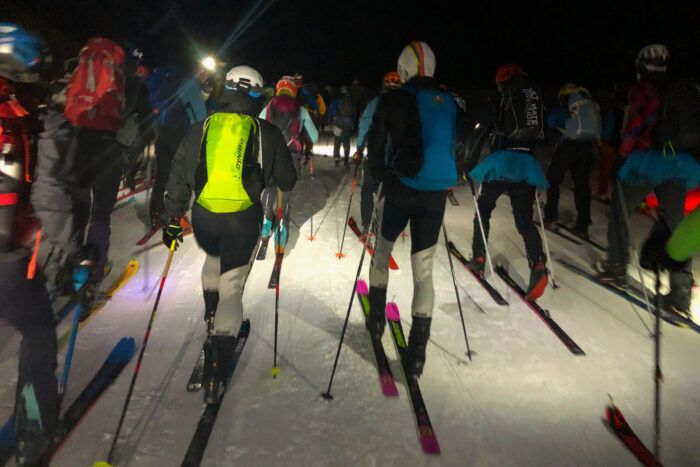
The Grand Traverse Skimo Race
It’s less of a starting line than a mob of anxious skiers standing in the cold ready to start moving. All 400 racers, roughly 200 teams of two, gather at the base of Crested Butte resort pointed uphill. Headlamps click on. Frozen breath and nervous heckles abound.
I scanned my kit one last time — of course, I made two or three last-minute adjustments.
A local reverend reads “The Blessing of the Freeheelers,” as is tradition.
“… Go ye with resolve that thy training was sufficient. Making all thy pole plants, kick, and glide most efficient. With the urging of Ullr, son of Thor by thy side. May ye be found worthy for thy perseverance will be tried. Take heart for this blessing accompanies thee on thy route. Now let the racers confirm thus with a great Grand Traverse shout!”
The gun fires and the starting line sprint commences as teams vie for skin track position. It’s 1.3 miles uphill to the first transition. Rip skins and start skating toward a few icy descents and notorious rollers to clear the resort boundary. By mile 4, you’ve made it to the backcountry, and it’s time to stick the skins back on for the next 13 miles.
In the Thick of It
The checkpoint cutoffs aren’t generous. A gear malfunction or blister mitigation break is all that it takes to knock out teams every year. The course is essentially two sections: before Star Pass and after Star Pass. Racers have until 7 a.m. on the dot to make it 17 miles and climb 5,000 vertical feet or they get turned around to self-extricate. No exceptions.
From there, it’s another 23 miles and 2,000 vertical feet of endless rolling wind-exposed alpine terrain to the top of Aspen Mountain on the northeast side of the Elk Mountains until one final glorious resort descent with whatever your legs have left.
The last checkpoint of the Grand Traverse, Barnard Hut, feels like a trap. The arguably hardest 7 miles lie ahead. But the siren song of hot ramen soup and basking in the morning sunlight lures wary racers to sit and rest. Linger too long, or sit at all, and your joints and muscles might lock up from fatigue. It’s best to push past it.
In any given year, 10-20% of teams DNF. Of those that do finish, times range from 6:06, the current course record, to over 18 hours. Regardless, finishers are greeted with a cheering crowd and a hot meal at the base of Aspen Mountain. There’s no sweeter relief than removing those boots — no matter how well they fit — after a long night in the pain cave.
That finish-line beer hits different when you haven’t slept in 24 hours.
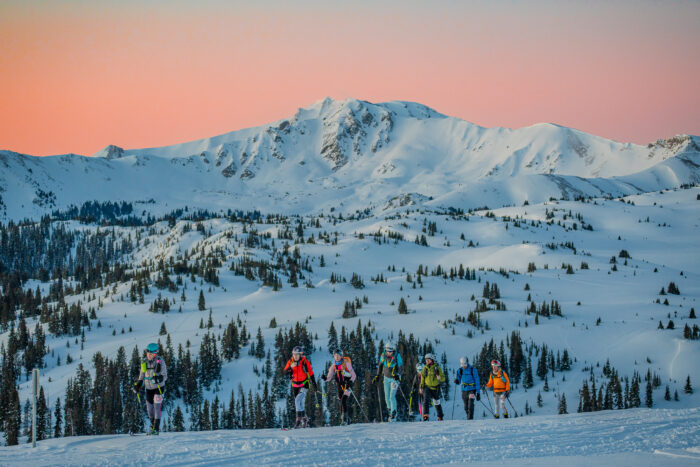
The Grand Traverse Run
As your average maybe-top-third athlete, I have a hard time describing which is “harder” — the Grand Traverse ski or the run. Both hurt in a Type III fun kind of way.
Where the ski race’s difficulty lies in the technical challenge, ski touring skills, and gear strategy, the run is more like a typical — albeit highly technical — trail running ultramarathon.
Racers are faced with 40 miles of rocky trails and 7K vert. Much of it is above treeline, in whatever conditions late summer brings. Smoky, scorching, or dumping rain are all within the realm of possibility.
The trail has some of everything; plenty of dirt roads and doubletrack, but also ankle-snapping rutted singletrack and rocky descents.
Running Gear
The gear strategy is minimalist compared to the ski portion given the aid stations sprinkled (lightly) throughout the course. The required gear list is three simple items — a waterproof shell with a hood, warm gloves, and a warm hat or buff.
You need to carry enough water and nutrition to get to the next one, about 5 to 10 miles. Most racers, even the fastest on the course, wear some type of lightweight running vest that carries soft water flasks on the shoulder straps.
Other than that, racers are encouraged to carry thermal layers, an emergency blanket, and a headlamp. As with the ski portion, the top racers are carrying the bare essentials. I, on the other hand, tossed in an extra pair of socks, a sun hoodie, extra leukotape, and a burrito (I work harder for a meal I don’t need to squeeze out of a tube).
The make-or-break for the run? Footwear. The wrong shoes will end your day slowly and painfully. And it’s not a particularly easy decision.
I had been waffling between my two favorite trail shoes before the race — the La Sportiva Jackal and the La Sportiva Mutant. The Jackal is plush, roomy, and comfortable. The Mutant is stiff, aggressive, and protective. Go too soft on footwear and the rocky alpine zones will eat your feet. Go too stiff and your joints will take the brunt of the endless impacts.
Every racer ultimately makes their own call informed by their training. I chose the Mutant and only cried once.
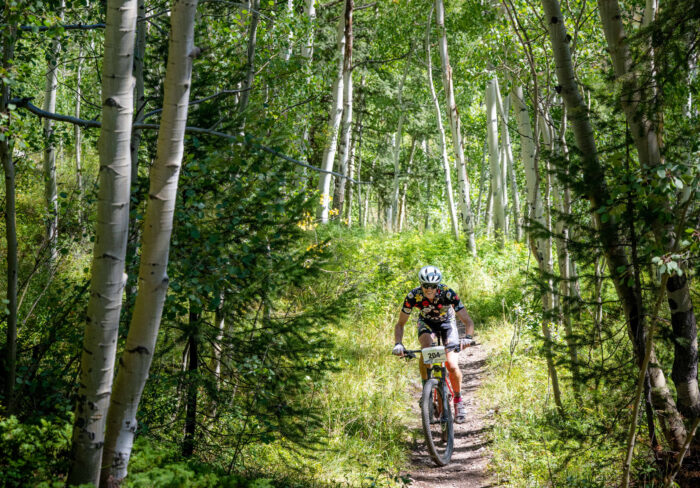
The Grand Traverse Bike Race
The Grand Traverse bike race is no cakewalk. Racers bask in significant mechanical advantage. But the trials are technical. Mechanical malfunctions and crashes are higher consequence than the other two races. Bonking (aka blood sugar depletion) is more frequent with the punchy nature of climbs and the high-intensity effort required to muscle a bike up technical terrain.
But the mechanical advantage means less time on the course. Four to 9 hours is the typical range. For the run, it’s between Cam Smith’s course record of 5:57:49 to 14 hours — less time being beaten down by the elements.
But here’s the kicker: The run and bike are back-to-back. So those looking for a triple crown finish, or even a dual-sport finish, start the bike race fully depleted from an ultra-marathon the day before.
I woke up the day of the race to a pair of feet that had swelled a full size overnight. Seven of 10 toenails were black and one was oozing. I scrambled to borrow a friend’s much larger bike shoes before stumbling to the starting line.
The Gear
The required gear list is the same as the run. But bikes are vulnerable to mechanicals, and that means most racers carry extra kit. A tube, multitool, and pump are about the minimum you can get away with.
The top racers pilot lightweight cross-country dream machines. The rest of the pack, as with the ski portion, crosses the Elks on a wide variety of setups, from lightweight hardtails to burly enduro rigs.
I found myself on the far end of the spectrum this time around. And not the end you’d want for this race. My trusty Transition Sentinel got the nod by virtue of my owning a single mountain bike. I can assure you that 35 pounds of hard-hitting aluminum rolling on meaty dual-ply Maxxis Minion tires was overkill by an order of magnitude.
It was light enough to finish, at least.
Conquering the Crown
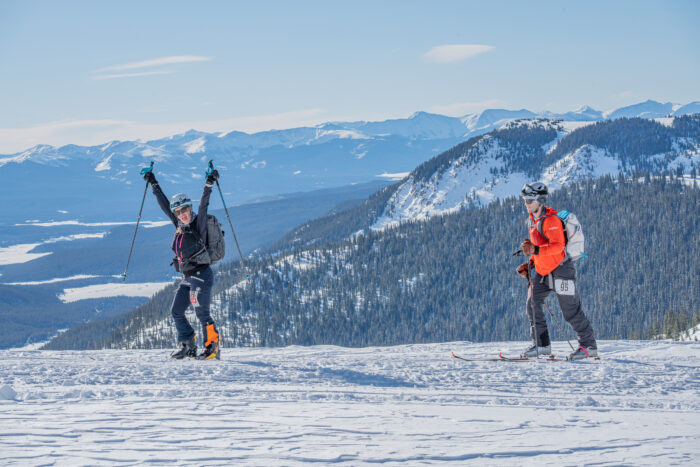
The Grand Traverse races are no different than other ultra-distance endeavors. The months of training and mental preparation, the endless lonely miles, and fighting through injuries is the hardest part. Once you’ve made it to the starting line — ski, run, or bike — it’s all execution.
Yes, the body will hurt. And self-doubt will creep in. Your gear strategy will fall apart and your feet will burst. Pulling each Grand Traverse race off, much less in the same calendar year, is tough. But that’s what makes it worth it. It’s what makes the Grand Traverse Triple Crown a preeminent mountain multisport, multiseason challenge.
Heed thy Reverend’s blessing, “… The spirit soars above thee as an eagle on the wing. Comforting thy torment and tempering its sting. Summon all thy vigilance and prepare to depart. For this epic competition will require all thou art.”
The Grand Traverse is made possible by support from Montane, Dynafit, Pomoca, Cripple Creek Backcountry, CAMP USA, Pinnacle Orthopedics, Crested Butte Mountain Resort, and Aspen Ski Co.
